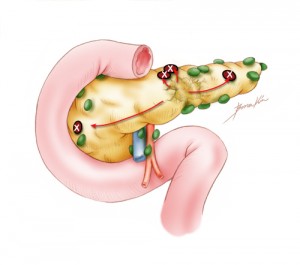 One of the most common questions we get is, “how is pancreatic cancer staged?” We are therefore updating our previous Blog posting of December 14th, 2010 on staging. Staging is so very important for two reasons. First, proper staging helps determine the most appropriate treatment a patient should receive. Cancers that are low stage (confined to the pancreas) are often best treated surgically, while cancers that are high stage (which have spread to organs outside of the pancreas) are typically best treated with chemotherapy and/or radiation therapy. Second, stage is an important prognostic indicator. While no two patients are alike, staging can provide a rough estimate of the typical life expectancy for patients with similar cancers. It should absolutely be noted that there are always exceptions, and that some patients live much longer than one would have predicted from their stage, while others succumb to their disease faster than one would have predicted from their stage.
One of the most common questions we get is, “how is pancreatic cancer staged?” We are therefore updating our previous Blog posting of December 14th, 2010 on staging. Staging is so very important for two reasons. First, proper staging helps determine the most appropriate treatment a patient should receive. Cancers that are low stage (confined to the pancreas) are often best treated surgically, while cancers that are high stage (which have spread to organs outside of the pancreas) are typically best treated with chemotherapy and/or radiation therapy. Second, stage is an important prognostic indicator. While no two patients are alike, staging can provide a rough estimate of the typical life expectancy for patients with similar cancers. It should absolutely be noted that there are always exceptions, and that some patients live much longer than one would have predicted from their stage, while others succumb to their disease faster than one would have predicted from their stage.
Because staging is so very important, we have updated our web pages that describe the proper staging of pancreatic cancer (http://pathology.jhu.edu/pc/DiagStaging.php). These updated pages provide new illustrations (an example of which is shown above) of the Seventh Edition Staging from the American Joint Committee on Cancer (AJCC). Details on staging can be found at: http://www.cancerstaging.org/
The staging of tumors of the pancreas uses the TNM staging system.
“T” in this system designates the extent of the primary tumor in the pancreas.
T0 No evidence of a primary tumor
Tis Carcinoma in situ (a precancerous lesion, such as an intraductal papillary mucinous neoplasm with high-grade dysplasia)
T1 Tumor limited to the pancreas and 2 cm or less in size
T2 Tumor limited to the pancreas and greater than 2 cm in size
T3 Tumor extends beyond the pancreas but it does not involve the blood vessels of the celiac axis or the superior mesenteric artery (two arteries that run close to the pancreas)
T4 Tumor involves the blood vessels of the celiac axis or the superior mesenteric artery (two blood vessels that run close to the pancreas)
“N” in the staging system designates whether or not the cancer has spread (metastasized) to lymph nodes in the region of the pancreas (regional lymph nodes)
NX Regional lymph nodes cannot be assessed
N0 No regional lymph node metastases (cancer has not spread to the lymph nodes)
N1 Regional lymph node metastases (cancer has spread to the lymph nodes, as shown above)
The “M” of TNM designates spread to other organs beyond the pancreas, also known as distant metastasis.
M0 No distant spread (no distant metastasis)
M1 Distant spread (distant metastasis, shown below)
Once the T, the N and the M designations are established for a given patient, they can be combined to determine the stage of the patient’s cancer using the chart below.
Stage 0 Tis N0 M0
Stage IA T1 N0 M0
Stage IB T2 N0 M0
Stage IIA T3 N0 M0
Stage IIB T1, T2 or T3 N1 M0
Stage III T4 Any N M0
Stage IV Any T Any N M1